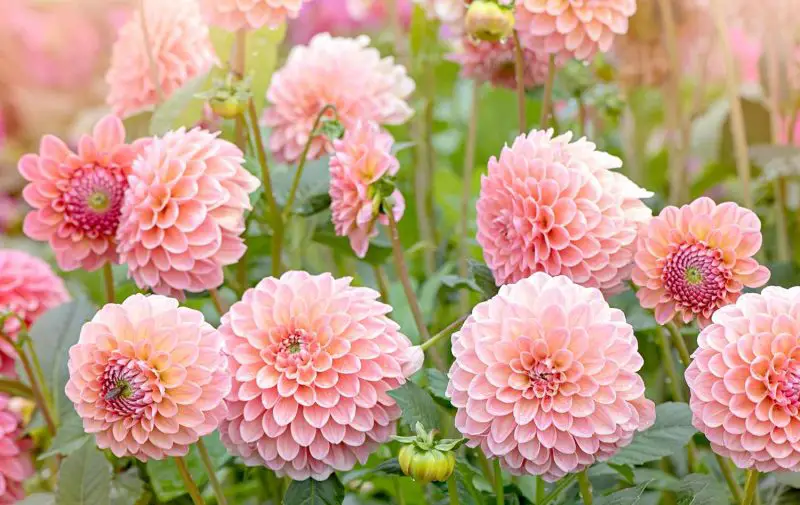Understanding Dahlia Bulbs and Their Growth Cycle

Dahlias grow from tuberous roots often referred to as bulbs, though technically they are tubers. These underground storage organs hold all the energy the plant needs to push out its lush foliage and brilliant blooms once temperatures rise. To time planting right, gardeners must understand the life cycle of dahlias.
Dahlia tubers remain dormant through winter and only begin to grow when soil temperatures are consistently warm. Once planted, they begin sprouting stems and leaves in early to mid-spring, depending on local climate. The plants grow rapidly, reaching their full height in a matter of weeks and beginning to flower by midsummer. Blooms continue through late summer and into fall, as long as frost has not arrived.
Because dahlias are extremely sensitive to frost, the timing of their planting is closely tied to the local frost calendar. In colder climates, they’re grown as annuals, with tubers dug up at the end of each season and stored indoors. In warmer regions, dahlias may be treated as perennials, allowing the tubers to stay in the ground year-round. Knowing when your local frost ends in spring and returns in fall will help you decide the best window for planting. Whether starting in garden beds or containers, understanding this growth cycle ensures you get the most vibrant and extended bloom period possible.
When to Plant Dahlia Bulbs in Cold Climates (Zones 3–6)
In colder USDA zones, especially zones 3 through 6, planting dahlias too early can be disastrous due to the risk of late frosts. These regions experience a shorter growing season, so precise timing is essential to ensure the plants have enough time to grow and bloom before the first autumn frost.
The general rule of thumb is to wait until two to three weeks after your last expected frost date to plant dahlia tubers directly into the ground. This usually falls sometime in mid to late May, depending on your region. At this point, the soil should have warmed to at least 60°F (15°C), which is necessary for dahlia tubers to break dormancy and start growing. Planting in cold or wet soil may lead to tuber rot or delayed sprouting.
Gardeners in these zones may also consider pre-sprouting their tubers indoors four to six weeks before planting outdoors. This method gives dahlias a head start, ensuring earlier blooms during the brief summer window. Once the danger of frost has passed, and the soil is workable and warm, transplanting these pre-sprouted dahlias into prepared garden beds can result in stronger plants and longer blooming times.
Paying close attention to soil temperature, local weather patterns, and frost forecasts helps ensure successful planting and healthy growth in northern regions.
Best Planting Time in Mild and Coastal Climates (Zones 7–8)
Gardeners in zones 7 and 8 enjoy more flexibility when planting dahlias, thanks to their longer growing seasons and milder winters. However, planting too early can still result in poor emergence due to cool spring soils or surprise cold snaps. To ensure successful planting, wait until after the last average frost date and confirm that soil temperatures are consistently above 60°F (15°C).
This often means planting from mid to late April in most of these areas. Coastal regions that experience cooler springs may need to wait until early May. Unlike colder zones, gardeners here typically don’t need to dig up dahlia tubers in fall, especially in zone 8, where winters are usually mild enough to leave tubers in the ground with proper mulching.
To get the most from the longer season, many gardeners start tubers in pots indoors in March and move them outside once nighttime temperatures stay above 50°F (10°C). This can result in earlier blooms and bushier plants. However, planting directly in the garden once soil temperatures allow still produces great results.
Because mild climates provide extended blooming windows, regular deadheading and fertilizing can help plants continue producing flowers into October. Paying attention to regional microclimates, such as elevation or coastal winds, also allows for fine-tuned planting adjustments for even better results.
Planting Dahlias in Warm and Hot Climates (Zones 9–11)
Warm climate gardeners in zones 9 through 11 have unique advantages and challenges when growing dahlias. With minimal frost concerns, the growing season can start earlier, but extreme summer heat and humidity require thoughtful timing and care.
In these regions, the ideal time to plant dahlia tubers is in late winter to early spring, typically from late February through March. The goal is to establish strong growth before intense summer temperatures arrive. By getting tubers in the ground while the soil is warm but not yet overheated, gardeners can promote vigorous root development and early blooming.
However, extreme heat during mid to late summer may slow blooming or cause the plants to become stressed. To counteract this, choose planting sites with afternoon shade and improve soil with compost for better water retention. Mulching heavily can help regulate soil temperature and reduce evaporation.
In areas with extremely mild winters, dahlias may even be planted in fall for winter and spring blooming, provided they are protected from occasional cold snaps. However, most gardeners find spring planting yields better growth and flower performance.
Regular watering, especially during dry spells, is essential in these zones, and consistent deadheading keeps dahlias blooming through the long season. With proper timing and care, gardeners in hot climates can enjoy abundant blooms for many months.
Tips for Container Planting and Indoor Starts
Planting dahlia tubers in containers is a flexible method that benefits gardeners in any climate. It allows better control over soil conditions, moisture, and sun exposure, while also enabling early indoor starts in cooler regions or heat protection in warmer areas.
When starting dahlias indoors, begin four to six weeks before your local last frost date. Use large containers at least 12 inches deep to accommodate the developing roots. Plant the tubers horizontally with the eye facing upward, covering with 1 to 2 inches of soil. Keep the container in a warm, bright location, avoiding overwatering until growth appears.
In warm climates, containers can be placed outdoors earlier than in-ground plantings, particularly if kept in sheltered areas. This allows for early blooms before peak summer heat sets in. Use lightweight, well-draining potting mixes and feed regularly with a balanced fertilizer to encourage strong foliage and continuous flowering.
Once the threat of frost has passed in cooler regions, hardened-off container-grown dahlias can be moved into the garden or kept in their pots for patio or balcony displays. Containers should be rotated occasionally to ensure even sun exposure and prevent leggy growth.
This method is especially useful for gardeners with limited space, poor soil, or a desire for mobility and early color. With careful watering, fertilizing, and location management, container dahlias can perform just as well as their in-ground counterparts.
Soil Preparation for Dahlias
Creating the Right Foundation
To achieve the best flowering performance, dahlia bulbs need well-drained, fertile soil with excellent structure. Begin by choosing a site with full sun exposure, where the soil is loose and rich in organic matter. Dahlias dislike compacted or soggy soils, so if you have heavy clay, consider amending it with aged compost or coarse sand to improve drainage. The ideal soil pH for dahlias falls between 6.3 and 6.8. A simple soil test will help you assess if lime or sulfur needs to be added to balance the pH.
Timing and Tilling
Prepare your planting beds several weeks before the last expected frost. Till the soil to a depth of 12 inches to loosen it, allowing the tubers to develop freely. Incorporate well-rotted manure or compost during this process to boost nutrient content. Avoid using fresh manure, as it may burn tender roots or encourage fungal growth. In colder climates, raised beds can warm up faster and improve early planting conditions. A well-prepared bed not only supports better tuber development but also helps prevent root rot, promotes stronger stems, and improves flower size and quantity throughout the season.
Choosing the Right Planting Time by Zone
Matching Timing with Local Climate
Understanding your USDA hardiness zone is essential to choosing the correct time to plant dahlia bulbs. These tender perennials thrive in warm soil and must be protected from frost. In general, dahlias should be planted after the last spring frost date when soil temperatures consistently reach 60°F (15.5°C). Planting too early, when the ground is still cold and wet, can lead to tuber rot or delayed sprouting.
Zone-Based Recommendations
In Zones 8 to 10, where winters are mild, you can plant dahlias as early as March. In these zones, tubers can even be left in the ground year-round with proper mulching. For Zones 6 to 7, wait until mid to late April or even early May to ensure the soil is warm enough. In Zones 3 to 5, where the risk of late frosts is higher, planting should be delayed until mid to late May, or even early June in cooler years. In these colder areas, you might consider starting dahlias indoors in pots and transplanting them outdoors once the weather stabilizes. Adapting your planting time to your zone ensures better root development, stronger stems, and timely blooms.
Indoor Starting for Early Blooms
Why Start Dahlias Indoors?
Starting dahlia tubers indoors can give you a head start on the growing season, especially in regions with short summers or unpredictable spring weather. By giving your plants a few weeks of warm, stable conditions indoors, you can encourage earlier sprouting and more robust growth once they’re moved outside. This approach is particularly useful in Zones 3 through 6, where outdoor planting is often delayed until late spring.
How to Start Tubers Indoors
Begin about four to six weeks before your area’s last expected frost date. Choose containers that are at least 6–8 inches deep with good drainage. Use a loose, well-aerated potting mix and plant each tuber horizontally, just below the surface with the eye facing up. Place the pots in a warm, bright location—ideally near a sunny window or under grow lights—maintaining temperatures around 65–70°F (18–21°C). Water lightly until sprouts appear, then increase watering slightly as growth accelerates. Once the risk of frost has passed and soil outside is warm, harden off your plants gradually before transplanting them into the garden. This method not only shortens the time to flowering but also boosts your chances of vibrant, healthy plants.
Soil Preparation for Strong Roots
Understanding Soil Needs
Dahlias thrive in loose, well-draining soil that is rich in organic matter. Heavy or compacted soils, especially clay, can retain too much moisture and lead to rotting tubers. Before planting, it’s important to evaluate your soil’s texture and structure. In general, a sandy loam or well-amended garden soil works best, allowing young roots to develop freely and access oxygen. A slightly acidic to neutral pH range between 6.0 and 7.0 is ideal for nutrient uptake.
How to Improve and Prepare the Planting Area
Start by loosening the top 12 to 18 inches of soil to promote deep root growth. Incorporate compost, well-rotted manure, or leaf mold to increase fertility and drainage. If your soil tends to be dense or holds water, consider adding coarse sand or perlite to lighten the structure. Avoid using high-nitrogen fertilizers at this stage, as they may promote excessive leafy growth at the expense of blooms. Instead, a balanced fertilizer with phosphorus and potassium can help strengthen root development. Before planting, ensure the soil has warmed to at least 60°F (15°C) to prevent tuber rot and encourage fast sprouting. Well-prepared soil not only supports healthy plants but also increases bloom size and longevity throughout the season.
Watering Strategies Based on Climate
Adjusting Watering for Different Conditions
Watering dahlias correctly is essential for establishing healthy roots and maintaining vibrant blooms, but watering needs vary greatly depending on your climate. In cooler, wetter regions, natural rainfall often provides sufficient moisture early in the season, so supplemental watering should be minimal to avoid soggy soil. In contrast, gardeners in hot or arid climates must irrigate more frequently, especially during long dry spells or once plants begin to grow actively. Overwatering is just as risky as underwatering—it can lead to tuber rot or fungal issues. Always monitor soil moisture before watering.
Timing and Techniques for Effective Irrigation
When starting with dahlia bulbs, it’s best to hold off on heavy watering until the first shoots emerge. Watering too early while the tubers are still dormant increases the risk of rot. Once growth begins, water deeply but infrequently to encourage strong root development. Morning watering is preferable, giving foliage time to dry before evening. In dry climates, a layer of organic mulch around the base helps retain moisture and regulate soil temperature. Consider installing drip irrigation or soaker hoses for efficient watering without wetting the leaves. This approach supports steady growth and reduces stress, leading to more robust plants and fuller blooms throughout the season.
Fertilization for Bloom Abundance
To encourage abundant dahlia blooms, apply a low-nitrogen fertilizer such as 5-10-10 or 10-20-20 that supports root development and flowering rather than leafy growth. Begin feeding once shoots emerge and continue every three to four weeks throughout the growing season. In sandy or nutrient-poor soils, you may need to feed more frequently, while rich loam soils require less. Avoid over-fertilizing, as this can lead to weak stems and fewer flowers. Stop applying fertilizer about a month before your area’s first frost to help plants prepare for dormancy. Whether you use a slow-release granular product at planting or a water-soluble option for ongoing feeding, consistent nutrition—combined with proper watering and full sunlight—ensures strong, vibrant dahlias that bloom prolifically well into fall.
Protecting Dahlias from Weather Extremes
Dahlias are sensitive to temperature fluctuations, and protecting them from weather extremes is essential for healthy growth and lasting blooms. In regions with hot summers, provide afternoon shade or plant them in locations with filtered sunlight to prevent wilting and leaf scorch. During heatwaves, mulching with organic materials like shredded bark or compost helps regulate soil temperature and retain moisture. In windy areas, dahlias benefit from staking or being planted near windbreaks to prevent stem breakage. As fall approaches and temperatures dip, cover plants with frost cloth or lightweight row covers overnight to shield them from early frosts. Consistent moisture and drainage are also crucial, especially during heavy rains—ensure soil doesn’t become waterlogged, which can lead to root rot. By anticipating and mitigating harsh conditions, you give your dahlias the best chance to thrive and extend their blooming season.
FAQ
When is the best time to plant dahlia bulbs in colder climates?
In colder zones (3–7), wait until the danger of frost has passed, usually in late spring, when soil temperatures reach at least 60°F (15°C).
Can I start dahlia bulbs indoors before transplanting?
Yes, you can start them 4–6 weeks before your last frost date in containers indoors to encourage earlier blooms outdoors.
Do dahlias need full sun?
Dahlias thrive in full sun, ideally 6 to 8 hours per day. Less light can lead to fewer blooms and weaker plants.
How deep should I plant dahlia bulbs?
Plant the tubers 4–6 inches deep with the growing eye facing up and space them about 18 inches apart for good air circulation.
Is it okay to plant dahlias in containers?
Yes, dahlias do well in large containers with well-draining potting mix. Choose compact or dwarf varieties for best results.
What if I plant too early and there’s a frost?
If a late frost is expected, cover young shoots with frost cloth, buckets, or row covers to prevent cold damage.
Do I need to fertilize dahlias after planting?
Use a low-nitrogen fertilizer once shoots emerge and continue every few weeks to promote strong stems and abundant flowers.
Conclusion
Timing is everything when planting dahlia bulbs. By choosing the right moment based on your climate and preparing your soil well, you set the stage for healthy growth and vibrant blooms. With consistent care—watering, feeding, and protection from harsh weather—dahlias will reward you with stunning flowers all season long. No matter where you garden, proper timing and attention ensure the best results.






